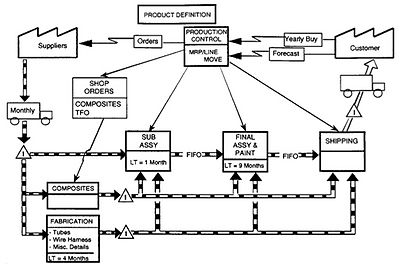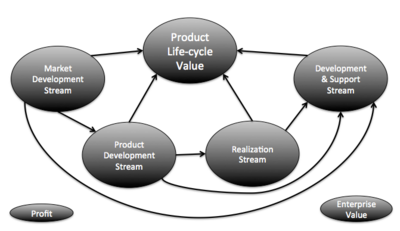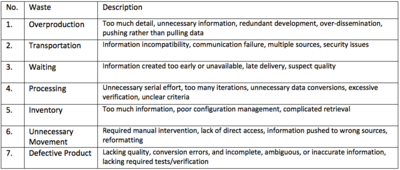Value Stream Mapping in Program Management
Developed by Nils Echterhoff
“All we are doing is looking at the time line from the moment the customer gives us an order to the point when we collect the cash. And we are reducing that time line by removing the non-value added wastes.”[1] (Taiichi Ohno, 1988)
Value Stream Mapping (VSM) is a widespread tool in Lean manufacturing environments. It enables practitioners to distinguish between value adding and non-value adding activities, supports to eliminate the waste, and thereby gain efficiency. The ongoing extension of Lean principles to applications other than production also involves the VSM methodology. VSM, as well as other concepts, therefore need to be adapted to the specific new purposes and environments.
Contents |
Background
Lean Thinking
The term Lean Thinking was introduced in the best-selling book “The Machine That Changed the World: The Story of Lean Production”[2] published by the MIT International Motor Vehicle Program (IMVP) in 1990. The term was further established in IMVP’s second bestseller “Lean Thinking: Banish Waste and Create Wealth in Your Corporation” [3]. In their in-depth study of Toyota’s prominent Toyota Production System (TPS) the authors James P. Womack and Daniel T. Jones identified a basically new management paradigm. Already in the 1970’s scientists and practitioners, with Edward Deming leading the way, started to explore Japanese management techniques. Prior Japanese companies had overtaken U.S. consumer electronics and auto markets by higher quality and cheaper products. The outcomes were single practices such as Total Quality Management (TQM) and Six Sigma, which were later adopted by Lean Thinking.[4]
The essence of Lean Thinking can be represented by the concepts value, waste and process of creating value without waste. Value is basically interpreted as “what the customer says it is, considers important, and is willing to pay for”[4] while waste can be described as "any human activity that absorbs resources but creates no value”[5]. Regarding that, Lean Thinking assigns any work activity to either:
- Value Added Activities (VA);
- Required Non-Value Added (RNVA or Type I waste) or;
- Non-Value Added Activities (NVA or Type II waste).[3]
Furthermore, Ohno divided waste into seven different forms, which also help to identify waste at all.[1] The process of creating value without waste is further defined through six widely accepted Lean Principles (see section "Progression of VSM within Lean Context").
Over the years Lean Thinking became the dominant paradigm through many major industries. Based on Toyota’s lean TPS, as a role model for efficiency in manufacturing systems[6], many large companies established and developed their own “holistic” systems (e.g. Bosch Production System, Mercedes Benz Production System). The triumph in repeatable manufacturing temporary led to the misconception, that the concept is not applicable in one-off work environments. Despite this, Lean Thinking was successfully transferred to various fields of application including product development and engineering. [4]
Value Stream Analysis and Value Stream Mapping
Although the headline of this article names only Value Stream Mapping, this article also includes its preceding method named Value Stream Analysis (VSA) as they are undoubtedly connected by their nature. To understand this connection as well as the differences, the two methods will be briefly introduced.
VSA is an examination method, which applies Lean principles to focus on business activities that are adding value to a final product and in this manner forming a value stream in aggregate. VSA can be understood as “a method by which managers and engineers seek to increase the understanding of their company's development efforts for the sake of improving such efforts” . The method aims and depends on local process knowledge, but combines it invariably with a holistic systems perspective.[7] In short, VSA identifies the value streams that can subsequently be approached by VSM.
By contrast to VSA, VSM can be seen as “the method by which the outcomes of Value Stream Analysis are depicted or illustrated” . VSM provides a simplification of highly complex systems into a less complex two-dimensional model. In this way this visual tool allows brighter insights and understanding of a system and furthermore constitutes an essential basis for the communication of the latter. [7]
VSM originates from the TPS, where the method is called “Material and Information Flow Mapping” and used to depict current, future or ideal states in the process of installing lean systems. The western term was coined by Mike Rother and John Stock, who recognized the potential of Toyota’s implementation method even beyond the original usage. In “Learning to See: Value Stream Mapping to Add Value and Eliminate Muda“[8], which is a known classic among practitioners, they provide a formalization of VSM (e.g. standard symbols) and describe its application as a training method.
Progression of VSM within Lean Context
As mentioned above the process of creating value without waste can be described by six Lean principles named:
- Value
- Map the Value Stream
- Flow
- Pull
- Perfection[3], and
- Respect for People.
Especially the sixth principle is of critical importance for the success of the implementation of Lean Thinking.[4] The Value Stream orientation of the principles assumes, that activities adding value to a product are always stringed together to a stream, which can be analyzed and mapped to reduce waste and continuously improve products. The more waste is banned, the closer the Value Stream comes to the ideal state of providing value across the entire enterprise[3].
Manufacturing Application
Due to the manufacturing roots of Value Streams and to the fact that the analysis and mapping of physical material flows is more straightforward then creative, iterative and information-based flows like in engineering development operations, Lean Principles have been taken to a notable higher level of perfection within the manufacturing application.[7]
In the light of this, a major step regarding the spread of VSA and VSM was made with the publication of implementation guides providing formalized and robust methods for practitioners. Figure 1 shows an example Value Stream with a symbolisms basically following the standard reference “Learning to See”[8].
The application of VSA/VSM follows a fundamental scheme. At first, a Current State of a Value Stream is mapped by examining the production floor. Then, by applying the Lean principles like the elimination of waste, an improved Future State map is created. This is then used to generate an implementation plan that needs to be executed. This pattern of continuous improvement is applied repeatedly, while the Value Stream gets leaner and thus closer to an ideal state with every single loop.[8] Furthermore the method can be used to introduce the right cycle times according to the customer’s requirement cycle, as well as identify the system’s lead time.
In order to characterize processes within the Value Stream, to support improvement decisions and measure achievements, VSM applies a number of metrics. Table 1 shows a selection of commonly used ones.
When the principles are communicated clearly, a standardized symbolism and terminology are in place, the use of VSA/VSM allows cross-communication and unfolds its abilities to improve manufacturing efficiency significantly. “Improvements of 30-90% in factors such as floor space required, production operators, production lead time, and amount of work in progress are common results of Lean efforts.”[7]
This outstanding success of the implementation of Lean Thinking through VSA/VSM has encouraged other domains, including program management, to adopt this effective scheme and align it to their own requirements.
Program Management Application
As mentioned above, the concepts of VSA/VSM have been applied to several areas. So has it to Program Management (PM). Although there are quite a few publications addressing PM explicitly, most of them concern about one of PM’s major applications, more particularly Product Development (PD). In the light of this, the remainder of this article will mostly speak about PD, which can be seen as a representative of the PM domain.
Starting in 1994 one of the first groups engaged into the application of Lean Principles within PD was the Product Development Team from the Lean Aerospace Initiative of Massachusetts Institute of Technology (MIT), who’s members were representatives from military and industry, as well as academics. During the following years they developed their idea of Lean PD, so that it was addressing the majority of the founding Lean Principles.
Value, the first principle, is proposed as "a capability delivered at the right time, for the right price, as defined by the end user" which joins into the output of an effective and usable product design package.[3].
This design package is meant to be the outcome of a Value Stream, equal to a product that derives from a manufacturing Value Stream. Furthermore this outcome needs to be in sequence with other activities in the business cycle, to create an overall value as depicted in Figure 2.
The principle of flow is, in contrast to the flow of material in manufacturing, about information that flows through the PD process. The quality of the flowing information is determined by the characteristics Form, Fit, Function, and Timeliness (FFFT), which are described below[9]. Despite this definition, Value is not only determined by FFFT, but also influenced of how suitable the design package is, in order to allow the final product to meet the customer’s desired FFFT.
- Form: information must be in concrete form, explicitly stored.
- Fit: information must be in a form that is useful to downstream processes and provided seamlessly.
- Function: information (in the form of a design) must satisfy end-user and downstream process needs, and communicate an acceptable amount of risk.
- Timeliness: the right information at the right time.
While information flows through the Value Stream, equal the material in manufacturing, tasks are adding value and thereby transforming it from raw data to wisdom, as outlined in Figure 3.
Despite this scheme, not every bit of raw data makes its way to wisdom. Therefore every single piece of data would have to end up in the final design. are adding value to the information. According to the fact, that not necessarily every activity adds value to the information, the seven categories of waste were applied to information. Table 2 presents the result.
While the Lean Principles of Value, Value Stream, Flow, and Waste have been initially defined and applied in the context of PD, the PD Team of MIT’s Lean Aerospace Initiative has not had sufficient equivalents for Pull, Perfection, and People at the time of publication.
Nowadays, the application of Lean Principles has been matured. The lately published “The Guide to Lean Enablers for Managing Engineering Programs”[10] draws a clear and detailed picture about the application of Lean Thinking in PM. By presenting their Lean Enablers, the authors even provide solid links between Lean PM and VSM. Hence, it offers a potential framework for the exploitation of VSM within PM. But as the book does not cover the implementation of VSM, it remains a potential.
Proposed Tools for VSM within PM
After the Lean Principles of Value and Value Stream have been taken to PD, as a representative PM application, the actual mapping, i.e. visualization, may be explored. In contrast to manufacturing, there is a variety of tools used in the PM practice, whereby some are based on “Learning to See” (REF) while others are not necessarily intended for use in the mapping of a Value Stream. Due to the complexity and quantity of methods, this section will only give a brief overview.
Product Development Value Stream Mapping (PDVSM) is a highly complex tool that is based on Rother’s and Stock’s standard work. It was coined by Hugh McManus, who begun developing it alongside the Lean Aerospace Initiative at MIT. To study PDVSM a variety of extensive documentation is available including the 2005 published “PDVSM Manual”. Compared to “Learning to See” PDVSM comes with a number of additional symbols, such as “Action Task”, “Review Task”, “Decision Task” or “External Factor”. Further methods used by practitioners are those not necessarily intended for this purpose. Among these are:
- Gantt Chart,
- Ward/LEI Map,
- Process Flow Map,
- System Dynamics, and
- Design Structure Matrix (DSM).
Discussion
All in all, the described situation shows, that the application of VSM in PM, respectively PD, is not as straightforward as it is for the manufacturing application. Two main reasons can be identified.
Firstly, the nature of information, in contrast to material, is not tangible and therefore not supporting the visualization. Also complex procedures, such as iterations, impede the application.
Secondly, it can be said, that there is no practical equivalent to “Learning to See”. The PDVSM method of McManus might be matured, but is highly complex, the guide covers 100+ pages and it is easy to lose the overview.
For these reasons there is a need to simplify the methods, as well as literature, in order to make VSM in Program Management accessible for a wider range of practitioners.
References
- ↑ 1.0 1.1 Taiichi Ohno: Toyota Production System: Beyond Large-Scale Production, 1988
- ↑ James P. Womack, Daniel T. Jones, Daniel Roos: The Machine That Changed the World: The Story of Lean Production, 1991
- ↑ 3.0 3.1 3.2 3.3 3.4 James P. Womack, Daniel T. Jones: Lean Thinking: Banish Waste and Create Wealth in Your Corporation, 1996
- ↑ 4.0 4.1 4.2 4.3 Bohdan W. Oppenheim: Lean For Systems Engineering with Lean Enablers For Systems Engineering, 2011
- ↑ Wallace J. Hopp, Mark L. Spearman: Factory Physics, 2001
- ↑ Javier Santos, Richard Wysk, José Manuel Torres: Improving Production with Lean Thinking, 2006
- ↑ 7.0 7.1 7.2 7.3 Richard L. Millard: Value Stream Analysis and Mapping for Product Development, 2001
- ↑ 8.0 8.1 8.2 Mike Rother, John Shook: Learning to See: Value Stream Mapping to Add Value and Eliminate Muda, 2003
- ↑ Hugh L. McManus: Product Development Value Stream Mapping (PDVSM) Manual 1.0, 2005
- ↑ Josef Oehmen: The Guide to Lean Enablers for Managing Engineering Programs, 2012




